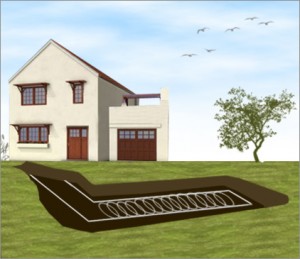22
2011
What is a Geothermal Slinky Loop?
 Installing a geothermal heat pump closed loop with horizontal or vertical configuration requires some digging in the ground around your house. The more earth the excavators have to move means the more you have to pay and the longer the whole process is going to take. Recently, some geothermal heat pump installers have hit upon an innovative way to decrease the surface area needed for installation and cut out the amount of digging they have to do. The method also shares some similarities to a popular children’s toy from the mid-20th Century.
Installing a geothermal heat pump closed loop with horizontal or vertical configuration requires some digging in the ground around your house. The more earth the excavators have to move means the more you have to pay and the longer the whole process is going to take. Recently, some geothermal heat pump installers have hit upon an innovative way to decrease the surface area needed for installation and cut out the amount of digging they have to do. The method also shares some similarities to a popular children’s toy from the mid-20th Century.
Everybody loves the slinky. At least, that was the pitch line of the coiled metal loop marketed to children for decades. The slinky was basically an engineering trick that was amusing to see in operation – rapid expansion and contraction providing pseudo-movement to an inanimate object. Though it would take some time to catch on, the particular configuration had applicability to the geothermal heat pump industry.
It turns out that pipes laid in a slinky configuration are as efficient as pipes assembled in straight horizontal or vertical lines. This means that the installer can coil the pipes to get the same amount of surface area exhaust for the system while decreasing the overall surface area of actual ground needed. This innovation can make some geothermal heat pumps easier and cheaper to install especially in areas where space is at a premium.
The shape is the obvious reason for calling them slinky loops, but there is another one. The official scientific name is “curtate cycloid.” That sounds more like alien-robot monsters that might descend from outer space to wreak their cold-hearted vengeance upon the entire human race rather than a geothermal heat pump installation technique! Yes, well, slinky loop it is then.





